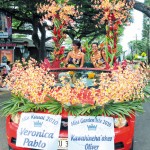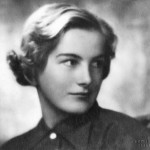Koloa Plantation Days: Where our history comes alive
Koloa Plantation Days is where Kaua’i history and our present merge. It’s a celebration of a unique way of life passed on from generation to generation
“It was 1935 when I first attended the Koloa Plantation parade,” recalls Betsy Toulon, a lively 94-year-old with sharp blue eyes and a sparkling smile. “I was 17 and we came down from the mountains to meet my sister Sandie (Knudsen). She married (Koloa Plantation) manager Hector Moir and lived where Plantation Gardens is now. My dad built the house for them out of lava rock because, naturally, that’s all that was around.”
- Betsy Toulon at her Kilauea home | Daniel Lane photo
- A scene from a previous parade | Photo from Koloa Plantation Days
- Historic Koloa Plantation Days Parade includes horseback and walking units, floral floats, vintage cars and decorated vehicles. Photo courtesy Koloa Plantation Days
Mrs. Toulon and I are reminiscing about Koloa’s plantation era at her home in Kalaheo. Down a grassy hill, cows graze lazily under the late-morning sun and the Pacific Ocean yawns in the distance. Joining us are Arryl Kaneshiro, Melissa McFerrin Warrack, Cheryl Shintani and Betsy’s nephew Peter Baldwin.
“Kekaha Sugar used to hire high school kids during the summer,” says Baldwin, who is on the organizing committee for Koloa Plantation Days. “We worked as hard (in the fields) as the regular guys, and they paid you a fair salary. We would start out with lots of energy, and the old Filipino guys would be way behind us. But by the end of the day, they were so far ahead of us!”
Stories like these tie the community together during the annual Koloa Plantation Days. The 10-day family-oriented festival, which began July 19 and runs through July 28, includes a parade in Koloa followed by a party at Anne Knudsen Park. In between, there are more than 25 events that celebrate plantation heritage and the vitality of today’s South Shore. Recognized as a signature event in Hawaii, the festival honors Hawaii’s first sugar plantation. This year the theme is “Stories of Our Heritage.”
“My family came in the early 1900s,” says Kaneshiro, who works for Grove Farm. At 32, he is the youngest board member on the Koloa Plantation Days committee and has been parade chairman for the past several years.
“My great-grandfather immigrated from Okinawa and my great-grandmother was a picture bride. They raised my grandpa and their family in what was called ‘Banana Camp,’ right behind the Koloa baseball park. My great-grandfather worked for the plantation before he started farming animals, and M & H Kaneshiro hog farm is still around today.”
In 1948, Grove Farm purchased the 3,000-acre Koloa Plantation and its sugar mill.
From 9 to 11 a.m. Thursday, July 25, Kaneshiro will host a mill tour where guests get to see the mill up close and learn about its history. Vans will shuttle people to Waita Reservoir and Wilcox Tunnel, which is usually closed to the public because it’s on private land. Originally, the tunnel was constructed to transport sugarcane from fields in Lihue to Koloa Mill. Seating is limited, so call 245-3678, ext. 222, to reserve a spot.
“Grove Farm was being charged an awful lot to mill their cane at Lihue, and they got fed up with it,” says Toulon. “It was just at the end of the war (World War II), and (Grove Farm manager) William Middleton Moragne Sr. bought machinery for cheap from the military. Then he tested all of the mountains to see which had the most solid part of the Haupu Range. They started from either end, and ended up exactly right in the middle.”
- Betsy’s father, Eric Knudsen, at the 100th year anniversary parade of Koloa Sugar Plantation
- In the front seat of the carriage is Eric Knudsen with Betsy’s stepmother Hazel Knudsen. In the back, stepsister Karin Latham, sister Anne Knudsen Baldwin and Betsy at the 100th year anniversary of Koloa Sugar Plantation Parade
- Punahou graduation picture of Betsy Toulon at age 18. Photo courtesy Betsy Toulon
On Friday, July 26, retired pastor Niles Kageyama will share the culture, food, values and traditions that he grew up with as part of camp life at Koloa Plantation. During this talk story at the historic Koloa Missionary Church, Kageyama will show slides of what life was like during that time. Afterward, you can learn about the history of Old Koloa Town during a guided tour led by Gail Little.
“Right across from Sueoka store, there’s a shower tree by the Koloa Plantation Days Monument that was planted by Jean Ariyoshi, the wife of Gov. Ariyoshi,” says event organizer McFerrin Warrack, whose husband Jim Warrack will be driving a 1965 Ford Mustang during the parade. “It was the Millionth Tree of Aloha.
“A few years ago, the governor and his wife returned as the parade grand marshal and encouraged Phyllis Kunimura to keep this festival going, because it’s valuable to bring people together and remember. This year marks the 28th annual Koloa Plantation Days and Betsy Toulon will be the parade grand marshal.”
Make sure to come early for the parade because the road closes at 9 a.m. About 40 intermediate and high school kids will perform in the Kaua’i contingent of the Hawaii All State Band.
“These kids plus kids from all over the state practice on their respective island, then meet up on Oahu for a final practice,” explains Kaneshiro, “then they fly to Pasadena to play for the Rose Parade. At the Koloa Plantation Days parade, they’re going to have hula, Tahitian dancing and a marching band.”
“This festival takes place because the community comes together to make it happen,” says McFerrin Warrack. “It’s a unique event because you have residents who grew up in the area planning it with area nonprofits, institutions and businesses as well as the visitor industry. That combination creates an event where residents and visitors can experience a diverse range of local foods, culture and activities.”
For more information, visit KoloaPlantationDays.com.






